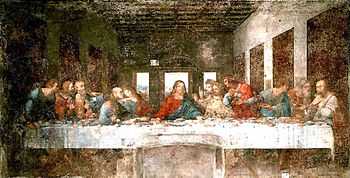Venus and Amor
 | |
| Artist | Hans Holbein the Younger |
|---|---|
| Year | c. 1524 |
| Type | Oil and tempera on limewood |
| Dimensions | 34.5 cm × 26 cm (13.6 in × 10 in) |
| Location | Öffentliche Kunstsammlung, Basel |
Venus and Amor (also known as Venus and Cupid) is a c. 1524 painting by the German painter and printmaker Hans Holbein the Younger, conserved in the Kunstmuseum Basel, Switzerland. Although the work is Holbein's earliest mythological painting,[1] depicting the Roman goddess of love, Venus, with her son Amor (Cupid), the model is believed to be his friend Magdalena Offenburg.[2] They are shown in front of a large hanging green curtain and behind a low parapet. Venus is depicted with an open gesture and sincere gaze. Cupid is seen climbing onto the parapet while holding love's arrow in his left hand.[1] He has red-orange hair, rendered in the same colouring and tone of the rich cloth sleeves covering his mother's upper arms.
Venus and Amor was painted after Holbein's return to Basel following a short stay in France. While in France, he had access to the collection of Francois I,[3] and it's believed likely that this work was one of his early responses to his exposure to the Italian painters of the era.[4] Such influences can be seen in the gesture of Venus, whose pose closely echoes that of Jesus in Leonardo's 1498 Last Supper.[3][5] In addition, her long, oval, idealised face seems closely modeled on Leonardo's depictions of the Virgin Mary.[6]


Leonardesque portrait painting was very popular across northern Europe during the 1520s, and it is generally believed that a number of Holbein's works from this period were direct attempts to seduce and gain favour from potential wealthy patrons. The art historians Oskar Bätschmann and Pascal Griener wrote in 1999 that, as with the artist's similar Lais of Corinth, Venus' open hand is "stretched towards the beholder and prospective collector."[6] The model is the same as that used for his Darmstadt Madonna and for the Venus and Amor and Lais of Corinth, and has been identified as Magdalena Offenburg, who may have been the artist's mistress.
The work was first mentioned when it came into the possession of the collector Basilius Amerbach in 1578 as a gift from his cousin, Franz Rechburger. Amerbach's inventory records that the work was formed as a portrait of a lady from the Offenburg family, however this claim has not been substantiated by art historians. The Web Gallery of Art notes that "even if Holbein did make use of a portrait study, he has idealised his model to the point where it can no longer be considered a true portrait."[1]
Notes
- ↑ 1.0 1.1 1.2 "Venus and Amor". Web Gallery of Art. Retrieved on 17 May 2009.
- ↑ Toman, 382
- ↑ 3.0 3.1 Batschmann et al, 135
- ↑ Batschmann et al, 147
- ↑ Holbein was fascinated by Leonardo's work, which he knew largely through engravings, and completed his own Last Supper in 1524
- ↑ 6.0 6.1 Batschmann et al, 158
Sources
| Wikimedia Commons has media related to Venus and Cupid. |
- Batschmann, Oskar & Griener, Pascal. Hans Holbein. Reaktion Books, 1999. ISBN 1-86189-040-0
- Toman, Rolf (ed). Renaissance: Art and Architecture in Europe during the 15th and 16th Centuries. Bath: Parragon, 2009. ISBN 978-1-4075-5238-5